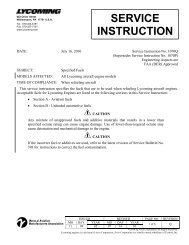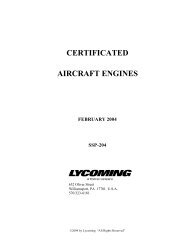You also want an ePaper? Increase the reach of your titles
YUMPU automatically turns print PDFs into web optimized ePapers that Google loves.
VI. WHAT DOES THE OIL FILTER TELL?<br />
Clean oil has consistently been an important factor in aiding<br />
and extending engine life. A good full-flow oil filter has been<br />
a most desirable application here. When the filter is exchanged,<br />
ask the mechanic to open it and carefully examine for any foreign<br />
elements, just as is accomplished at oil change when the<br />
engine oil screen is also examined for the same purpose. Just<br />
as the spark plugs tell a story about what is going on in the<br />
engine, so the engine oil screen and the external oil filter tell<br />
a story about the health of an engine. Whether the engine is<br />
equipped with an oil filter or just a screen, oil changes should<br />
have been accomplished in accordance with the manufacturer’s<br />
recommendations. These oil changes should have been recorded<br />
in the engine logbook.<br />
If oil is analyzed, it should be done at each oil change in order<br />
to establish a baseline. Analysis is a tool which only gives useful<br />
information when a dramatic departure from the established norm<br />
occurs. (See “Spectrometric Oil Analysis” later in this section.)<br />
VII. COMPRESSION CHECKS<br />
What has been the trend in compression in at least the last two<br />
differential compression checks? The differential compression<br />
check is the more reliable type and should be taken on a warm<br />
engine. If the differential check reveals 25% loss or more, then<br />
trouble may be developing.<br />
Some operators are confused by the compression check and<br />
its application. A compression test should be made anytime<br />
faulty compression is suspected, anytime the pilot<br />
observes a loss of power in flight, when high oil consumption is<br />
experienced, or when soft spots are noticed while hand pulling<br />
the prop.<br />
Many maintenance technicians do a compression check at each<br />
oil change, and it is also considered part of the 100-hour engine<br />
inspection and the annual inspection. Most experienced mechanics<br />
feel that the differential compression check is best used to chart<br />
a trend over a period of flight hours. A gradual deterioration of<br />
charted compression taken during maintenance checks would be<br />
a sound basis for further investigation.<br />
VIII. SPARK PLUGS<br />
The spark plugs when removed and carefully observed, tell the<br />
skilled mechanic what has been happening in the cylinders during<br />
flight, and can be a helpful factor in deciding what to do with a<br />
high-time engine:<br />
1. Copper run out and/or lead fouling means excessive heat.<br />
2. Black carbon and lead bromide may indicate low temperatures,<br />
the type of fuel being used, and possibly excessive richness of<br />
fuel metering at idle.<br />
3. Oil fouled plugs may indicate that piston rings are failing to<br />
seat, or excessive wear is taking place.<br />
4. The normal color of a spark plug deposit is generally<br />
brownish gray.<br />
5. In high compression and supercha rged engines,<br />
0 L y c o m i n g F l y e r<br />
a cracked spark plug porcelain will cause or has been caused<br />
by preignition.<br />
IX. ENGINE MANUFACTURER’S RECOMMENDED<br />
OVERHAUL LIFE<br />
Service Instruction 1009 is the <strong>Lycoming</strong> published recommendation<br />
for operating hour and calendar year limits until<br />
engine overhaul as they apply to each specific engine model.<br />
The amount of total operating time on an engine will be a basic<br />
factor in any decision to either continue flying, change, top or<br />
major overhaul the power plant. Operators should be reminded,<br />
however, that the hours of service life shown in the service<br />
instruction are recommendations for engines as manufactured<br />
and delivered from the factory. These hours can normally be<br />
expected, provided recommended operation, periodic inspections,<br />
frequent flights and engine maintenance have been exercised in<br />
accordance with respective engine operator’s manuals.<br />
If an operator chooses to operate an engine beyond the recommended<br />
limits, there are factors to consider. The cost of overhaul<br />
is likely to be greater as engine parts continue to wear, and the<br />
potential for failure may also increase.<br />
Operators who have top overhauled their engine at some point in<br />
the engine life invariably want to know if this extends the life of<br />
the engine. This is an important question. The chances are that<br />
if the operator applies the checklist we have been discussing and<br />
comes up with favorable answers to these questions about his<br />
engine, he can probably get the hours desired — with only a few<br />
exceptions. But a top overhaul does not increase the official life<br />
or TBO of the engine.<br />
We are surprised from time to time to have owners tell us they top<br />
overhauled their engine at some point less than the major overhaul<br />
life for no reason other than somebody said it was a good idea.<br />
Unless the manufacturer recommends it, or there is a problem<br />
requiring a top overhaul, this is a needless cost. If the engine is<br />
healthy and running satisfactorily, then leave it alone!<br />
One other point deserves attention here; there is no substitute<br />
or cheap route to safety in the proper maintenance or correct<br />
overhaul of an engine.<br />
CONCLUSION:<br />
Apply all of these basic nine points concerning your engine<br />
or engines and then make a decision whether to top overhaul,<br />
major overhaul, exchange engines or continue flying.<br />
QUESTION: I hear the term “Shower of Sparks” relative<br />
to ignition systems. What does this term mean to pilots?<br />
ANSWER: It means that while the engine is cranking during<br />
a start, a prolonged series of sparks is jumping the spark plug<br />
gap as compared to one single spark. This results in improved<br />
cold-weather starting.







